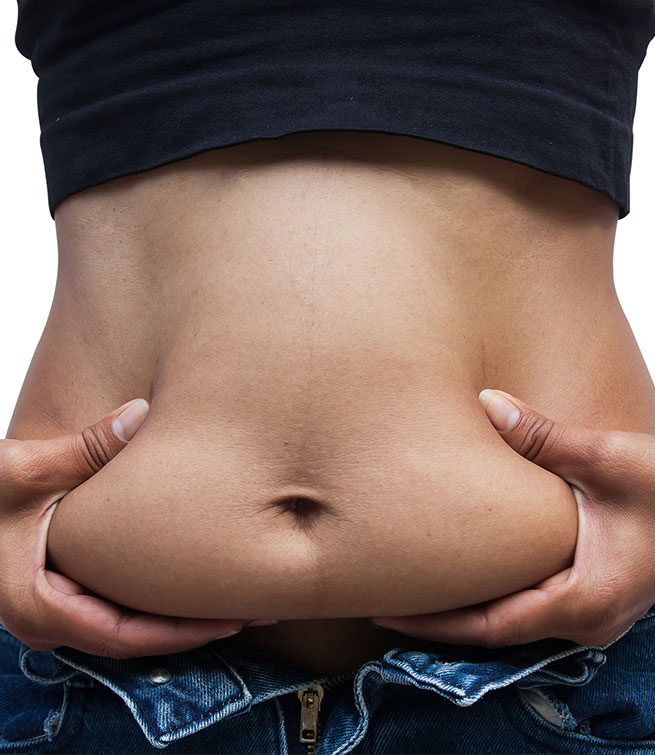Liposuction and abdominoplasty: What’s the difference?
Maybe you’ve tried it all — weight training, sports, diets, personal trainer, etc. — and nothing works. Sometimes, all this effort just isn’t enough to get or return to a flat stomach.
Fortunately, there are two more options to relieve the unpleasantness and discomfort that can be caused by an increased amount of fat and skin in the lower abdomen.
This article will talk about liposuction and abdominoplasty. Although a consultation is still the best way to find out which of these two procedures is right for you, we hope this article will help to guide your thinking and answer all your questions!
Liposuction or abdominoplasty?
Liposuction permanently removes excess fat from the treated areas. In fact, when sucked through cannulas inserted through tiny incisions, fat cells (adipocytes) that cannot multiply are removed for good. The likelihood of a repeat procedure is low, as long as you continue to live a healthy lifestyle!
This is an outpatient surgery performed under general anaesthesia or local anaesthesia with sedation, and it lasts a very short time (between 20 minutes and two hours, depending on the case).
Also known as abdominal lipectomy or a tummy tuck, abdominoplasty involves more than liposuction, because excess fat AND excess skin are removed (mini abdominoplasty). In some cases, the abdominal muscles are also repaired (complete abdominoplasty).
In short, liposuction removes only fat, while abdominoplasty is a full cosmetic and restorative surgery.
Who is abdominoplasty for?
If you have excess fat but your skin has not stretched, liposuction may be enough to correct the situation. If your skin is stretched and loose, your surgeon may recommend a mini tummy tuck.
Aside from the aesthetic aspect, some people experience significant pelvic and back pain due to the loosening or separation of the abdominal muscles (diastasis); abdominoplasty also repairs and restructures the muscles of the abdominal wall.
Weight fluctuations, hormonal imbalances, multiple pregnancies, the natural aging process and a sedentary lifestyle are the main factors that lead to muscle changes and/or excess fat and skin around the stomach area.
About the surgery
Both mini abdominoplasty and complete abdominoplasty are carried out under general anaesthesia and last between one and three hours. The surgery is performed in three main steps:
- Liposuction of the entire abdomen (stomach and sides) to shape the body and strengthen abdominal muscles (if needed for diastasis);
- Ablation of the excess skin located between the pubis and the navel, and repositioning of the navel if needed (umbilical transposition);
- Tummy tuck (tightening the remaining skin).
One or two drains are put in place during the surgery to reduce the risk of postoperative seroma and hematoma. These are removed during one of the follow-up visits.
You will wear an abdominal girdle immediately after the operation. It must be worn for two weeks following the operation, and only at night for two more weeks.
Recovery and results
Scarring
Like any surgery, abdominoplasty leaves scars. The first one marks the horizontal incision above the pubis. The second one, in the case of umbilical transposition, is in the form of a circle around the navel.
It is important to avoid exposure to the sun (or UV tanning) in the months following the procedure to avoid intensifying the appearance of the scars.
Resuming activities
Taking one to four weeks off work is suggested, depending on the case, and sports should be avoided for several weeks after the surgery.
Pain is moderate, but higher for complete abdominoplasty because the abdominal muscles are reworked during the operation. Painkillers will help to relieve the pain.
Results
The benefits of this surgery are aesthetic, of course, as well as physiological and psychological:
- Feeling of well-being and lightness
- Balanced body
- Slim shape
- Self-confidence
But in order to maintain all these benefits, it’s important to lead a healthy lifestyle. Therefore, it is advisable to eat a balanced diet and exercise to tone your muscles.
The final result is progressive: after a few weeks, the bruising disappears, edema decreases and the appearance of the scar greatly improves if you take good care of it.
If you have any questions or concerns, or if you would like a consultation so we can have a candid, honest talk about your condition, please contact me by clicking here: Dr. Étienne Cardin-Langlois.
I would be delighted to reassure you and give you all the information you need to make the decision that’s right for you.
Back to blog
